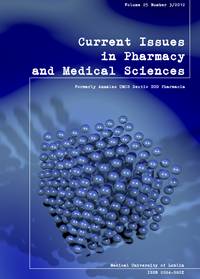Ozone, bacterial biofilm and dental caries – a review of literature
DOI:
https://doi.org/10.12923/j.2084-980X/25.3/a.06Słowa kluczowe:
ozone, ozone therapy, caries, dental prophylaxisAbstrakt
Ozone is an allotrope of oxygen in the form of triatomic molecules (O3). Recently, ozone and ozone therapy have become an object of ever increasing interest in the sphere of medicine and dentistry. In the paper the mechanisms of action, ozone’s influence on human organism and the role in medicine are discussed.
Bibliografia
1. Azarpazhooh A., Limeback H.: The application of ozone in dentistry: a systematic review of literature. J. Dent. 36, 104, 2008.
2. Bartosz G. (2003): Druga twarz tlenu. Wolne rodniki w przyrodzie. PWN Warszawa
3. Baysan A., Beighton D.: Assessment of the ozone-mediated killing of bacteria in infected dentine associated with non-cavitated occlusal carious lesions. Caries. Res. 41, 337, 2007.
4. Baysan A., Lynch E.: The use of ozone in dentistry and medicine. Part 2. Ozone and root caries. Prim. Dent. Care. 13, 37, 2006.
5. Baysan A., Lynch E.: Clinical reversal of root caries using ozone: 6-month results. Am. J. Dent. 20, 203, 2007.
6. Bocci V. et al.: The ozone paradox: ozone is a strong oxidant as well as a medical drug. Med. Res. Rev. 29, 646, 2009.
7. Bowden G.H.W.: The microbial ecology of dental caries. Microbial Ecology in Health and Disease 12, 138, 2000.
8. Brazzelli M. et al.: Systematic review of the effectiveness and cost-effectiveness of HealOzone for the treatment of occlusal pit/fissure caries and root caries. Health. Technol. Assess. 10, iii, 2006.
9. Dähnhardt J.E., Jaeggi T., Lussi A.: Treating open carious lesions in anxious children with ozone. A prospective controlled clinical study. Am. J. Dent. 19, 267, 2006.
10. Dukić W., Dukić O.L., Milardović S.: The influence of Healozone on microleakage and fissure penetration of different sealing materials. Coll. Antropol. 33, 157, 2009.
11. Fejerskov O.: Changing paradigms in concepts on dental caries: consequences for oral health care. Caries. Res. 38, 182, 2004
12. Fejerskov O., Kidd E. (2006): Próchnica zębów. Choroba próchnicowa i postępowanie kliniczne. Wrocław Urban &Partner
13. Hauser-Gerspach I. et al.: Comparison of the immediate effects of gaseous ozone and chlorhexidine gel on bacteria in cavitated carious lesions in children in vivo. Clin. Oral. Investig. 13, 287, 2009.
14. Johansson E. et al.: Ozone air levels adjacent to a dental ozone gas delivery system. Acta. Odontol. Scand. 65, 324, 2007.
15. Knight G.M. et al.: The inability of Streptococcus mutans and Lactobacillus acidophilus to form a biofilm in vitro on dentine pretreated with ozone. Aust. Dent. J. 53, 349, 2008.
16. Knight G.M. et al.: Leave decay in my cavity? You must be kidding! Dent. Today. 29, 130, 2010.
17. König K.G.: Clinical manifestations and treatment of caries from 1953 to global changes in the 20th century. Caries. Res. 38, 168, 2004.
18. Limeback H.: The application of ozone in dentistry: a systematic review of literature. J. Dent. 36, 104, 2008.
19. Loesche W.J.: Role of Streptococcus mutans in human dental decay. Microbiol. Rev. 50, 353, 1986.
20. Longbottom C. et al.: Novel preventive treatment options. Monogr. Ora.l Sci. 21, 156, 2009.
21. Marsh PhD: Mikrobiologia jamy ustnej i jej wpływ na zdrowie jamy ustnej i na ogólny stan zdrowia. Dialog o profilaktyce 1, 4, 2008.
22. Mudway I.S., Kelly F.J.: Ozone and the lung: a sensitive issue. Mol. Aspects. Med. 21, 1, 2000.
23. Nogales C.G. et al.: Ozone therapy in medicine and dentistry. J. Contemp. Dent. Pract. 9, 75, 2008.
24. Robertson T.M. et al. (2010): Stomatologia zachowawcza. Wydawnictwo Czelej, Lublin.
25. Turska-Szybka A. et al.: Zastosowanie ozonoterapii w leczeniu próchnicy bruzd i szczelin w zębach przedtrzonowych. Nowa Stomatologia 1, 13, 2007.
Pobrania
Opublikowane
Numer
Dział
Licencja
Prawa autorskie (c) 2012 Autorzy

Praca jest udostępniana na licencji Creative Commons Attribution-NonCommercial-NoDerivatives 3.0 Unported License.


